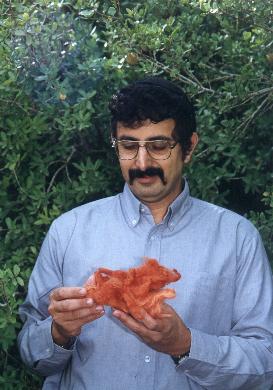It was mentioned in the books of Yosef ben Matityahu * Until now it was known that the aphid in question is only found in the Hararet area in Turkey. Now it was also found in Israel and the team members were able to extract the dye from it
Avi Blizovsky

At the "Innovations in the Study of Jerusalem" conference held under the auspices of the Ingeburg Rennert Center for Jerusalem Studies at Bar-Ilan University, the discovery of the "Second Worm" that was used to purify and dye precious fabrics a special orange color in the Temple was published for the first time. The discovery was revealed by Dr. Zohar Amar from the Department of Israel Studies named after Martin (Zos), who was able to locate the aphid and extract the "second" color from it.
'The second worm' is an aphid from the carmel family from which they produced the second color, which was used in the Biblical period and in the days of the Second Temple for holy and holy purposes. From all the sources that have been examined, it appears that this is a well-known, valuable and highly regarded color in the eyes of mankind at that time.
In the ancient world, mainly two types of aphids were used for dyeing: the oak aphid and the Armenian aphid, and it is not clear from the sources which one was used for sacred purposes in the Temple. In fact, most researchers believed that the source of the second color was in an aphid that originated outside Israel, since so far no aphid that produces the second color has been found in Israel. In research, which lasted several years, Dr. Zohar Amar, with the help of his student Zvi Tamri, located the Kermesidae species in Israel, which eventually led to the identification of the sought-after oak aphid and the extraction of the second color from it. The color obtained was orange and corresponds to what is described in the historical sources, mainly contributed to by the description of Joseph ben Mattathias, which is the last evidence of the use of the second worm in the Temple.
The Armenian aphid that grows on the root neck of certain cereal plants was found in the Hararet Mountains in Turkey and the tradition of using it continues to this day. From this aphid it is possible to produce a red-purple color for dyeing textiles.
Dr. Zohar Amar, the editor of the study, hopes to soon publish the entire study in its entirety, and at this point we can be satisfied with the fact that after about two thousand years we have succeeded in rediscovering the Haaretz-Israeli pinworm and the processes of extracting the dye from it.
https://www.hayadan.org.il/BuildaGate4/general2/data_card.php?Cat=~~~413360720~~~158&SiteName=hayadan

2 תגובות
What do you think if they make your blood paint for oil paintings? Everything will come back to you doubled and multiplied. All the suffering you cause aphids and animals in general will come back to you like a boomerang!